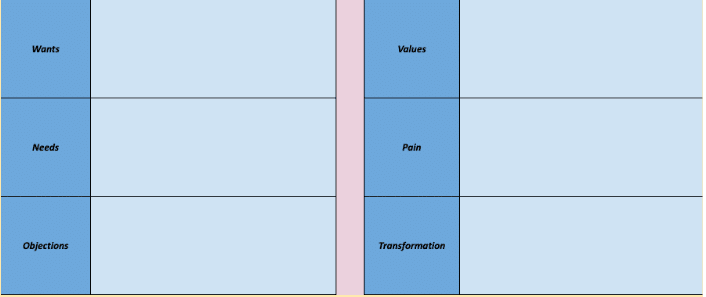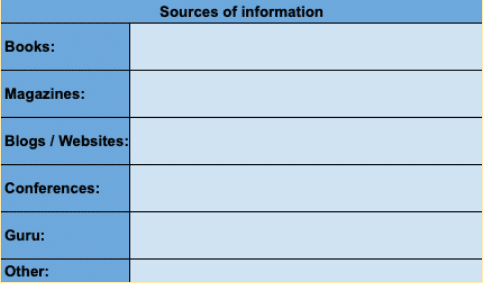Creating your customer avatar is the most valuable thing you can do in your business.
Not knowing who your customers are can seriously hurt your business.
Why?
Because if you don’t know who your target audience is, it’s almost impossible to create an effective marketing strategy.
So if you’re having problems finding your target market, getting the right message across, and converting more sales…you might need to create an avatar.
If you already have one, you probably need to update it.
The good news is, the process is simple and straightforward. There’s no previous marketing experience required. Anyone can do it.
You just need a solid process and a worksheet to create it. Lucky for you, you’re going to get both.
In this post, you’ll learn how to create your own avatar so you can:
- Identify your customers’ needs, wants, pain points and goals.
- Understand your customers’ purchasing decisions
- Improve your brand positioning
- Connect and build relationships
- Increase your brand awareness and convert more sales
Let’s begin.
Download your FREE Customer Avatar Worksheet

What is an avatar?
An avatar, also known as a buyer persona, is a profile that you create to describe who your ideal customer is.
People are naturally drawn towards businesses they trust. And to build trust, you have to connect with your audience on a deeper level.
Having a customer avatar helps you paint a picture of your customer – with specific details of their goals, challenges, and possible product/service objections.
You can then use that information to create relevant and personalized marketing messages – whether that’s via your emails, sales pages, or ads.
How long does it take to create an avatar?
One of the reasons why some businesses avoid creating an avatar is because it’s not a direct revenue-generating activity and sometimes, it takes too long to create, especially if you have more than one avatar like this business.
It usually takes around 2 hours to even a few weeks to create an avatar – depending on the information you have and how detailed you want your avatar to be.
If it’s your first time creating an avatar, just keep it simple. Start with one avatar, and make sure all the elements that build an effective avatar are there.
4 Elements of an Effective Customer Avatar
1. Demographic Information
Demographic information tells you who your target persona is. It allows you to bring your avatar to life.

In the Customer Avatar worksheet, write down the demographic details of your avatar.
This is the starting point. Demographics is the physical representation of your avatar. By identifying your avatar’s age, gender, location, and job, you’re creating a snapshot of what your avatar looks like.
To illustrate, let me ask you a question.
What comes to your mind when you hear the name Tony Stark?
If you know him, you probably thought of the following:
A guy who’s in his mid-40s (age), a billionaire (income), a genius inventor (occupation), one of the Avengers and the CEO of Stark Industries (job title).
Alternatively, you might have thought of the actor Robert Downey Jr.
If you’re not familiar with him, it’s totally fine
But here’s the point. It was easier to zone-in and become specific with the person I’m talking about because you have a clear picture of who he is.
That’s why a lot of businesses start with the demographics – they depict your target customer.
Unfortunately, most businesses stop there. While demographics are good to have, they aren’t enough. If you want to truly connect with your customers, you’re gonna need to know more about them.
That brings me to the next element in creating your customer avatar: Psychographics.
2. Psychographic Information

In the Customer Avatar Worksheet, flush out all the psychographic information of your avatar. You can use some of your answers in the tab “Questions to ask” here.
If demographics tells you who your customers are, psychographics information tells you why your customers behave the way they do.
This is key to understanding the reasons why people buy your product and stick to your brand.
Think about it. Brands like Nike and adidas sell the same type of products – athletic shoes. But why do some people prefer one brand over the other?
The secret lies in their customers’ psychographic information. Things like their customers’ needs, goals, wants, and values.
By understanding your customers’ behavior, you’ll find out what triggers them to make certain purchasing decisions that can even lead you to create new products.
Maybe you’re selling protein powders and you found out that one of the most common reasons why people don’t purchase it is because they can’t take it with them when they travel. With that in mind, you can tweak your offer and produce protein powders in sachets so your customers can easily take their protein shake anywhere, any time.
People have different needs and expectations. And by having a simple customer avatar, you can identify the outcome they want and align your products or services with it.
3. Sources of Information

In the Customer Avatar Worksheet, write down the sources of information of your avatar.
Have you ever noticed why it’s easy to connect with those who you have something in common with?
Maybe you read the same books, you listen to the same thought leaders, or you hang out in the same online forums.
Knowing your avatar’s sources of information helps you build rapport and establishes trust fast. Not only that, it also gives you the opportunity to be where your customers are.
A lot of business owners struggle with attracting the right customers. They simply don’t know where to find them, let alone know what to say in front of them.
But if you know where they hang out, and you truly understand their behavior – needs, pain points, goals – attracting and selling becomes so darn easy.
All you have to do is communicate what you know about them so they can resonate with you.
Once they feel that you truly understand them, you get their full undivided attention. And if you’ve been in the marketing and sales industry long enough, you know that attention is the ultimate commodity.
4. Your Offer and Story
If we know one thing about selling, we know that at its core it’s all about problems and solutions.
Here’s the thing. Most people don’t just buy products because they’re better, faster, or cheaper.
Sure, those are good reasons and they work well.
But what separates successful businesses from everything else is their stories.
“All marketers tell stories. And if they do it right, we believe them” – Seth Godin (Author of Linchpin)
Take a look at some of the world’s successful businesses’ stories:
Apple Computers: Jobs and Wozniak wanted to make computers small enough so people can use them at home or in their offices.
Virgin Airlines: The company started because of Richard Branson’s frustration with slow and mediocre airline travel.
Uber: Travis Kalanick and Garrett Camp couldn’t find a cab in Paris, so they came up with an idea that changed the world of public transportation – the ability to get a cab using your phone.
If your customer asks you, “Why are you selling this product or service?”
Saying “because I want your money” won’t exactly work.
What works is telling them the story behind your offer – and that story is really about why you’re helping your customers.
Ask yourself questions like:
- Why do I love this person?
- Why do you deserve to serve this person? What makes you qualified to help him/her?
- Why must I serve this person?
Keeping these questions in mind not only brings clarity on why you help your customers, it also keeps you grounded and motivated to continuously provide them value.
Creating an avatar is probably the most undervalued activity in all of business activities. But having a well-defined customer avatar will definitely improve your brand presence, the quality of your leads and ultimately, impact your business goals.
Want to get more awesome content like this? Subscribe to our YouTube channel. We post the latest updates about everything Google Ads, every single day.
Thinking about hiring a Google Ads agency? Read our Guide to Choosing the Best Google Ads Agency for Free!
Author
Bryan is the marketing manager at Solutions 8, and has been on digital marketing since 2018. When he’s not working, you’ll find him working out at a local gym, reading personal development books, or playing music at home. He feels weird writing about himself in third person.
 Bryan Caranto
Bryan Caranto











